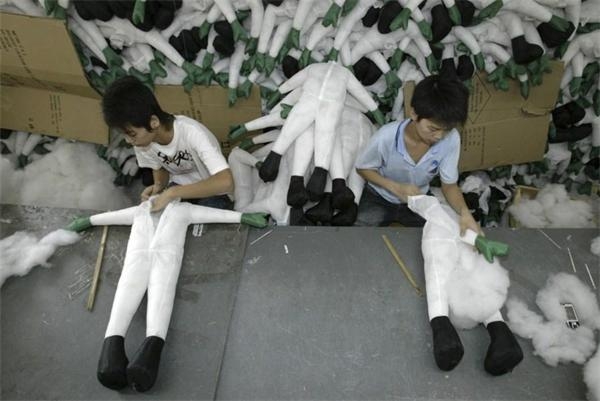


Photo: Workers in a Guangdong toy factory in 2007
Source: Hexun
By Yang Xingyun (杨兴云)
Issue 629, July 22, 2013
Nation, page 13
Translated by Laura Lim
Original article: [Chinese]
This is an extended abstract of an article that appeared in a recent edition of The Economic Observer, for more highlights from the EO print edition, click here.
The European Union, the world's second-largest toy market after the United States, has just implemented what it claims to be "the most stringent" set of regulations ever for the industry. Some fear that the so-called "Toy Safety Directive" could bring the toy industry in China, where 80 percent of the EU's toys originate, to its knees.
Zheng Guohui (郑国辉), a Hong Kong toy trader and one of the first to set up shop in the Pearl River Delta - a major manufacturing base for toys and other products - is convinced that the new directive may mean life or death for many of the toy manufacturers operating there.
Although the Pearl River Delta suffered huge losses during the 2008 financial crisis because of its export-led economy, it nevertheless remained stable as the market resized, Zheng says. However, the new safety instructions were a "game changer" that altered the rules of the whole industry and will lead to a fundamental "industrial reshuffle" (行业洗牌), he says. Zheng predicts that the effects will be seen in two or three years, when half of the toys companies operating in the region will not be able to survive.
On July 20, new rules about the chemical content present in toys sold in the EU came into effect as part of a Toy Safety Directive that was first published in June 2009. The new rules make significant modifications to product definition, safety performance, product conformity assessment and accountability, to say nothing of changing the rights of the various responsible parties.
There are now 57 clauses instead of just 16, and it is unquestionably the world's most demanding set of toy safety regulations.
For instance, the number of heavy metal tests have increased from 8 to 19 and 55 aromatic substances that could cause allergies have been banned. The new directive also strengthens the requirements in relation to chemical and electrical safety.
Guangdong Factories React to Stricter EU Toy Safety Rules
China is by far the world's biggest toy producer and exporter, accounting for two-thirds of global production. According to China's National Bureau of Statistics, it exported $13.9 billion worth of toys in 2012. Of that, the EU accounts for $2.6 billion, or 18.7 percent of total toy exports.
To help manufacturers deal with the new directive, Chinese authorities began offering, as early as 2011, 67 free counseling and coaching seminars to toy manufacturers in several of China's primary manufacturing regions. Nearly 10,000 people have participated in these courses, according to Sun Hong (孙红), a staff member of the Dongguan Entry-Exit Inspection and Quarantine.
For a recent training session in Dongguan, the State Quality Inspection Administration invited experts to conduct a comprehensive interpretation of the new regulations. Explanations were given for three major areas, including chemical safety, mechanical and electrical safety and technical archive files.
An Unavoidable Reshuffle
"The new EU directive's impact on the Pearl River Delta toy makers is manifold, notably in the examination of raw materials," says Liang Xiongjie (梁雄杰), brand director for Loong Run Toys Co. (东莞联弘玩具有限公司), which owns three factories in the region. Dongguan is China's largest export base for toys, accounting for more than 20 percent of all Chinese toy export. Almost all of the world's famous toy brands manufacture their products here.
As Liang points out, the new directive enforces requirements on product material quality and categories, necessitating considerable increases in production processes and costs. Meanwhile, the original product data dealing with specification, appearance and raw materials are to be preserved for 10 years.
The headache for Chinese manufacturers is that, in the past, a single $1 million order very often had just one standard specification. But now, out of caution within the market, the commissioning merchants require the same size order be made in a dozen specifications, categories and colors.
The increasing mobility of workers is another worry for Chinese toy manufacturers. While there are many assembly processes and complexities involved with the work, the industry offers relatively low pay compared to the electronics industry. The constant loss of skilled employees means it's difficult to maintain a high level of productivity while simultaneously guaranteeing technical requirements and quality.
Survival of the Fittest
The stricter regulations are being introduced in the world's second largest toy market just as China's toys manufacturing industry is going through tough times.
In May 2013 the value of toys exported from Guangdong was less than the amount exported in the same month a year earlier. This is the first time that this has happened in thirteen years.
There are, however, certain enterprises that regard the new regulations as a sort of challenge to enhance their own strength through healthy competition.
For example, Ru Dezhong (茹德忠), manager of Sieper Hardware & Plastic (思博五金塑胶(东莞)有限公司) - a German-owned company producing mainly plastic alloy toys in Dongguan - believes that "despite the 5 percent or so cost increase, the implementation of the new directive is a big plus for enterprises."
Ru is convinced that the new directive was a result of the global economic crisis and the European Union's way of creating a technical barrier to prevent the loss of toy industry manufacturing jobs at home.
"Were a manufacturer able to break through this barrier, it means the firm's competitiveness is at the high-end of the global market, whereas the ones that can't adapt themselves to the standards are at the lower end of the manufacturing chain," Ru says. "There's no point in just complaining. The manufacturers must effectively improve their competitiveness and shift to the high end of the industrial chain in order to ensure long-term profits."
Links and Sources
EU: Toy Safety Directive
News in English via World Crunch (link)

